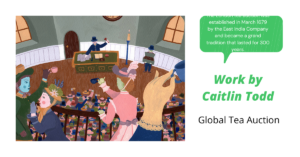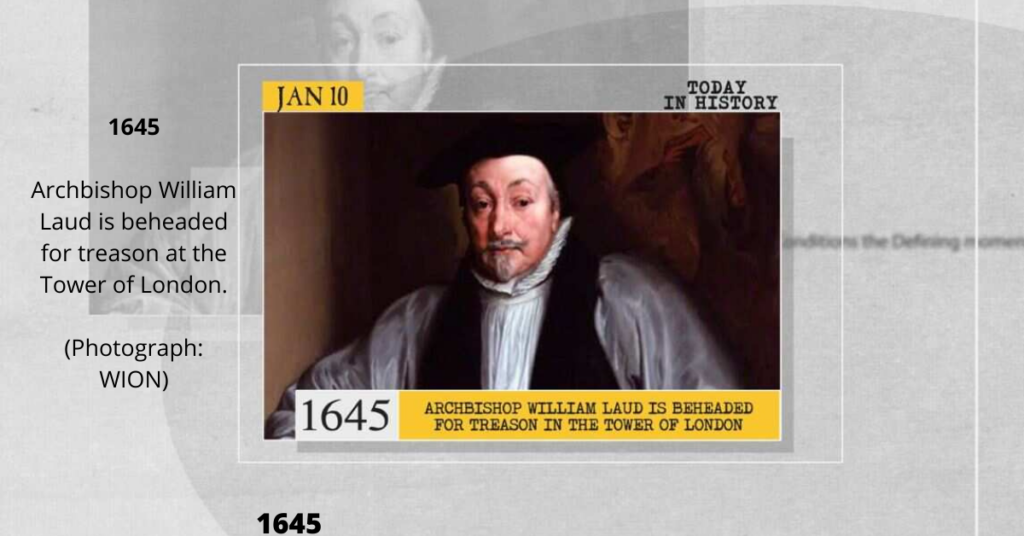With 77 percent of the world’s traded teas sold through public tea auctions in 2017, this marketing system remains highly topical and of great commercial efficiency.
Writen By Barbara Dufrêne.
The first tea auction in the Western world was set up in London as early as 1679, the United Kingdom being the biggest consumer market by then. The London Tea Auction was first established by the East India Company, which had obtained a Royal monopoly for goods imported from India and China. The auctions were held at East India House, the company’s headquarters. In 1834, the East India Company lost the trade monopoly and ceased to be a commercial enterprise. Tea had become a ‘free trade’ commodity and the tea auction moved from the East India House to the newly built London Commercial Salerooms on Mincing Lane. Within a few years, various tea merchants followed the tea auction and established their offices on Mincing Lane, which was then given the nickname of “Street of Tea.”
By the middle of the 19th century, tea had become such a popular beverage that auctions took place monthly, and then weekly. Tea was transported from Ceylon (now Sri Lanka), China, East Africa, and India for sale at the London auction, which devoted particular days of the week to each of the origin countries. By the 1950s, a third of the world’s traded tea was bought through the London auction. Once purchased, the tea was sent from the London warehouses either directly to the retailers that sold the tea per weight as loose-leaf teas, or to companies that specialized in blending and packaging. These companies – the tea packers – then sold the packed teas under various brand names.
Later, the London Tea Auction moved to Plantation House and then to Sir John Lyon House, and finally to the London Chamber of Commerce. However, after India, Sri Lanka and Kenya became independent states in 1947, 1948, and 1963, respectively, the activities declined gradually, and the London Tea Auction closed in June 1997. For almost 300 years the Western tea market had been dominated by the British Tea Trade and the memories and places of this important activity are currently being enshrined by the London Tea History Association (LTHA), which was founded in 2015. It is important to note that the British model pertains to the main producing countries where the British introduced commercial tea growing. All these countries established public Tea Auction Centres after independence.

Producing Countries Tea Auctions
From the mid-20th century, all colonial territories have progressively become independent states, be it from British, Dutch, German, Italian, Spanish, Portuguese, or Belgian rule. They, therefore, had to manage their agri-food and cash-crop economies on their own, and many followed along with well-established set-ups. The big tea-producing countries, India, Kenya, and its East African neighbors together with Malawi and of course, Sri Lanka, have created their own national tea-auction platforms, to ensure a regular trade flow. Today, there are public tea auction centers in India (6), Sri Lanka (1), Bangladesh (1), East Africa (1), Central Africa (1), and Indonesia (1), all based on the British model and all operating successfully, some of them for more than half a century. Not only are these auctions the best platform for ensuring satisfactory trade flows, but they are also the best possible mechanism for obtaining optimum prices, by ensuring fair competition through a fully transparent modus operandi.
A large range of producing countries grow tea mainly as a revenue crop and for export, namely East and Central Africa, Sri Lanka, Vietnam, and Indonesia, whilst the world’s two biggest tea producers, China and India, consume most of their teas themselves. Data from the International Tea Committee’s (ITC) 2018 Statistics Bulletin refer to traded teas, which represent 30.8 percent of the world’s production, amounting to 5.81 million tonnes in 2017.
In 2017, these 11 public tea auction bodies captured more than three-quarters of the international tea trade – a total tonnage of 1.38 million tonnes, which represents 77 percent of global tea exports, trade volume amounting to 1.79 million tonnes, per the ITC. Annual sales volumes range from around 400,000 tonnes (t) sold in 2017 by the EATTA Tea Auction in Mombasa, Kenya to around 10,000t sold in Limbe, Malawi, with Colombo, Sri Lanka has moved close to 300,000t and Kolkata, India around 170,000t of teas from Assam, Cachar, Darjeeling, Dooars and Terai.
Mike Bunston, OBE, who was chairman of the Tea Brokers Association at the time when the London Tea Auction closed, and who has chaired the International Tea Committee for 20 years and was appointed the Honorary Tea Ambassador for Ceylon Tea in London in 2014 confirmed, “I have always considered that auction selling is by far and away from the best form of selling tea. Not only does it provide for a maximum of competition, but more importantly, it is totally transparent, as the prices are openly announced and therefore known globally. Who are the biggest producers of tea other than China? India, Sri Lanka, and Kenya all have successful auction centers. They were set up along the British lines and have proved to be most successful over many years.”
Such internationally recognized tea auction platforms provide full international exposure, ensure complete transparency and allow teas to fetch competitive prices. However, in order to comply with the quality requirements for auction sale, the teas must be harvested with good picking standards, processed with performing factory equipment and after reaching the drier mouth they have to be sorted, graded, packed, and then labeled and identified as lots coming from named factories.
Auctions Focus on Black Tea
It should also be noted that the tea auctions mainly focus on traditional black teas, which remain the bulk of the tea exports and represent the major share of the world’s tea production, which was approximately 60 percent in 2017. Black teas fall into the two main categories of orthodox leaf tea and CTC (crush, tear and curl) tea, with the choice of the CTC process mostly related to the need to cope with large leaf volumes.

Both the orthodox and the CTC process have their traditional international grading system, which ranges from the largest leaf to the smallest. For Indian orthodox leaf, this will be SFTGFOP: special fine tippy golden flowery orange pekoe down to fannings and dust. For Indian CTC tea, this will range from BOP: Broken Orange Pekoe, down to dust. In East Africa, where CTC teas prevail, the grading will range from BP1: Broken Pekoe 1 to Pekoe Fannings, Pekoe Dust, and Dust.
BY–Barbara Dufrêne
There is no waste, and all leaf grades will find a buyer. All teas that go to the auction must be packed and fully labeled according to their estate details and grades.
Looking at the Mombasa Tea Auction reports, which indicate the average monthly prices fetched by the teas from the various East African countries, one can see how buyers appreciate the quality levels, with Rwanda clearly standing out with the highest prices.
The producing factories do not sell their teas directly, they entrust them to selling brokers, who are normally well-reputed tea professionals and registered with the auction centers, and who oversee preparing the auction catalogs. It is their responsibility to proceed with the tasting of teas, in order to cater to the requirements of the potential customers, with precise reference to particle size, taste profile, and cup color in particular.
To summarize the advantages of the auction system, it should be underlined that not only is there complete transparency with prices set in an open forum and information about who is buying, how much volume, and at what price, but all operators also pay the same price for the same tea, even the large multinational companies. Furthermore, it is an effective way of moving large volumes of tea from producers to buyers, which guarantees the good freshness, and payment is made within contractual delays, usually ten days, ensuring fast cash flow for the producers. Smaller producers can participate, which gives them access to the local, regional and international market, the standard unit being the pallet of 20 sacks. Smaller buyers can also participate as there is the possibility to divide the lots.

There is a cost for operating within such a fully organized platform, which is, however, considered to be a win-win investment for all the stakeholders.
It should be noted that there are currently no public auction centers in China because there is no standardized grading system for mainstream green teas and the long-standing regional spring and autumn fairs provide good sales opportunities for the stakeholders. Several attempts to introduce public tea auction platforms have not been carried through, which some experts explain by the huge variety of many regional teas and also the strong preference for dealing in privacy.
Prospects for Auctions in New Markets
There are tea-producing countries that favorably consider the advantages of the auction system and have made in-depth studies of the ways and means to introduce that way of selling their mainstream teas. Manuja Peiris, chief executive of the ITC, who started his tea career at the Colombo Tea Auction, has been involved in providing his expertise for introducing a tea auction platform. However, such a move requires some streamlining, compliance with more stringent production standards, and also improvements in production equipment, which means coordinated and important efforts, a target not easy to achieve.
There are also projects attempting to attract more of the small producers who make specialty and premium teas. Devising a system where smaller lots than 20 sacks could go through an appropriate accreditation with certified tasters sampling these specialty teas may well be feasible. The platform would also offer access to smaller buyers, like retail tea houses and specialty tea suppliers for the hospitality sector and culinary circles and who also sell via the net. The future will show if the auction system can be further extended to operate successfully in new markets and for new tea categories.
Barbara Dufrêne is the former Secretary-General of the European Tea Committee and editor of La Nouvelle du Thé. She may be reached at b-dufrê[email protected].
